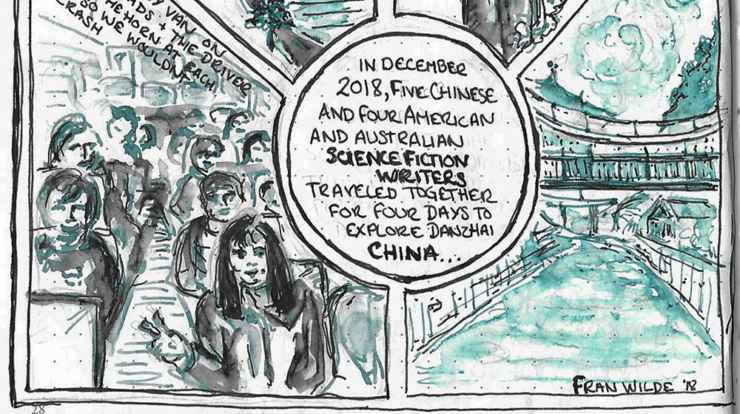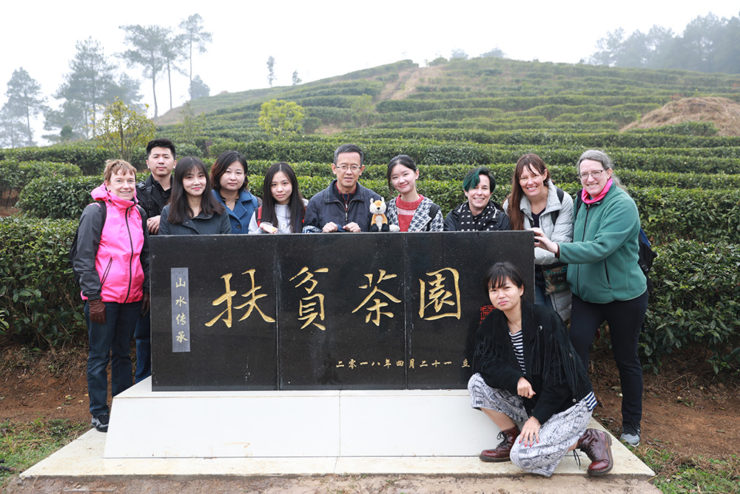Many writers keep journals. I’m one of them. I use journals to plot and plan (books, I promise, not murders), to figure out what I’m thinking about a particular topic or on a particular day, to remember what I’ve seen, or to look more deeply at what I’m experiencing, especially as I travel. Later on, I’ll go back through these journals and develop ideas into stories, essays, and more.
In early December, I joined fellow authors Naomi Kritzer, Tang Fei, Sam Murray, Han Song, Su Wanwen, Carolyn Ives Gilman, Lei Zhao, and Liang Ling in Guanzhou, China for several days during one of the harvest festivals for which the region is known. While there, we met cultural knowledge historians, village elders, local artists, tea farm supervisors, and one groundskeeper. The trip was sponsored by the Future Affairs Administration (FAA), who has published a short story of mine, and WANDA Group and focused on an area that has been designated for cultural support. Before going, and while there, I was very aware that this would be a highly curated trip—we saw and learned incredible things with the help of our guides.
Throughout our travels, all of us talked about the role that science fiction plays in different parts of the world. I was particularly excited to hear from Han Song (I’ve read his story “The Wheel of Samsara” in 2009’s The Apex Book of World SF, edited by Lavie Tidhar, and would like to read more of his work.) and Tang Fei, whose stories I’ve read in Clarkesworld (“A Universal Elegy,” translated by John Chu), and in Apex Magazine (“Call Girl,” translated by Ken Liu).
Getting to better know authors from China as well as the U.S. and Australia was a joy. Many of us took a lot of pictures and notes as we walked and drove and talked about what we were experiencing. And I, as I said above, kept a journal, as always.
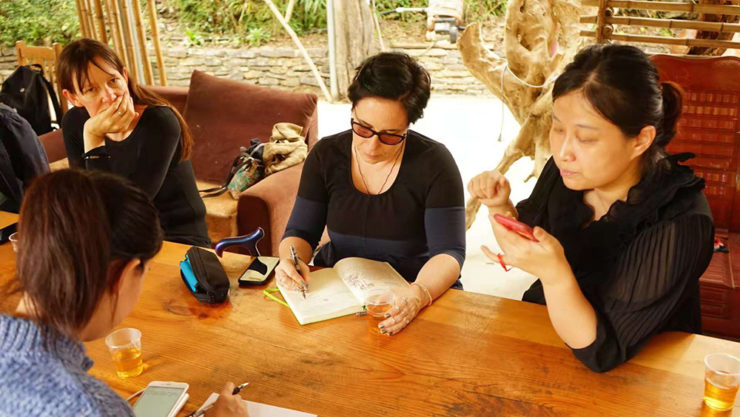
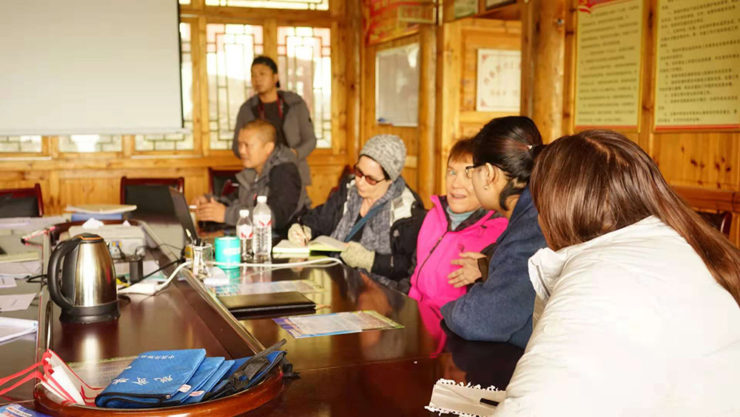
But something about this trip shifted my usual word-and-doodle note-taking into overdrive. The notes became more of a story than I’d planned, right on the page. I didn’t notice it until later, but I was increasingly using frame and image over and around words…and that use of frames—what was inside and outside the frame of the page, or the frame of each image, may be related to the fact that we were only seeing one area of China. Learning more about the region we visited, and about the many cultures living in the valleys and mountains away from the big cities was a wonderful opportunity. Yet I find it difficult to keep my mind off what was, and is, happening elsewhere that we were not seeing.
Recently, I’ve been talking with Tor.com about how I and others use illustrated notebooks as part of the work process, and I showed them my Danzhai journals when I returned. They’ve asked me to share a few pages, and I’ve agreed—both as a record of the time, and as a way to think about how storytelling and note-taking, especially as an outsider, is part of noticing details and thinking through experiences.
(The notes are my own speedy impressions at the time—spelling and likenesses may vary. I’m not sure what else will happen with these pages yet, but drawing this way was, for me, a decidedly different means of creatively experiencing a place.)
Day 1 (and a little of days 2 & 3… ): Danzhai, Tea, Many Official Meetings
We watched as author (and incredibly kind person) Han Song was named mayor for a day and planted a ceremonial tea tree; later, we traveled up a mountain to see a wall containing Miao history; spoke with the Danzhai Writer’s Council; and ate a traditional Miao feast (Note: Miao is a cumulative term used in China for cultures in the region including the Hmong and Mong).
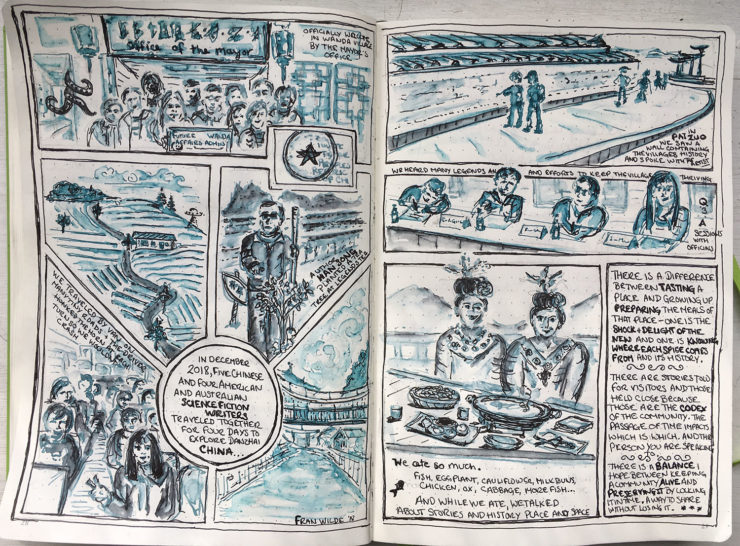
A Map of Where We Went
Many of us flew into Beijing, then took another plane to Guiyang, then drove several hours to Danzhai (Carolyn and I arrived at 3 a.m., after almost 30 hours of travel each). Over the course of the next several days, we took a small van through tea-growing areas, up into the mountains, and to an abandoned mineral mine.
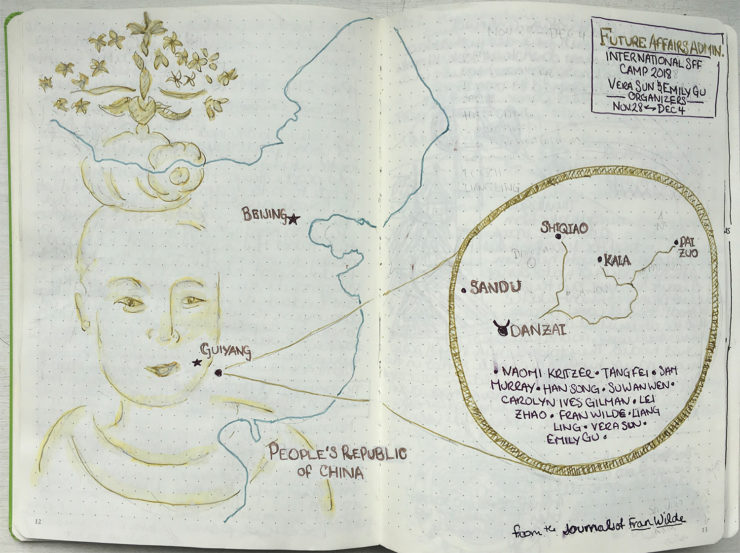
Day 2: The Mine & More
We walked throughout an old mineral (a search says gold and mercury) mine, then drove in the van through a mineshaft (I still can’t believe we did that), before ending up at a place none of us had expected to see: an abandoned prison, which had apparently held predominantly political prisoners. Han Song mentioned that at one point 800 prisoners had lived there, up to ten in a cell. Standing in the prison (I couldn’t climb the stairs with the others), I started to draw and noticed especially how far away the sky felt.
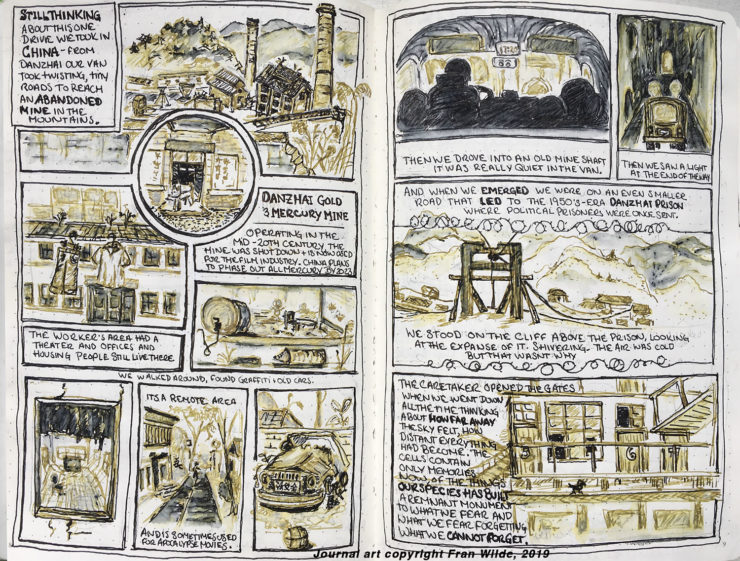
Day 3: Scenes from around Danzhai
I began sketching these at breakfast, and it took several different drawings for me to realize how deeply integrated the horn designs were in every part of the local structures.
One thing I like about sketching: it makes me look more closely at everything…and it sometimes helps me notice what I’m not seeing.
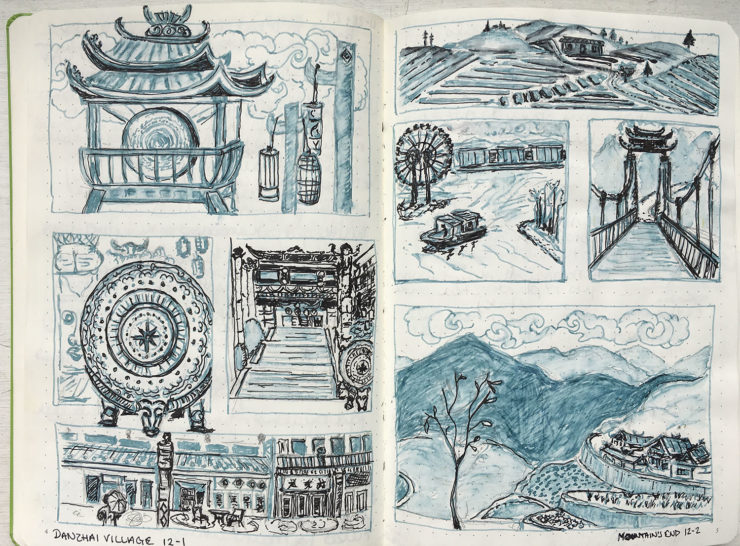
Day 4: Time to Go Home
On our way back to the airport, Naomi Kritzer, Carolyn Ives Gilman, and I discussed what had made the SF Week organized by the Future Affairs Administration (FAA) such a powerful and thought-provoking experience. We talked about the people we’d met and what we’d learned. Talking through our many thoughts and questions, we wondered if we would return. We wondered whether we’d be asked at some point “where was the Science Fictional Element?” since this was a science fiction writer’s trip…and as we said that, we passed an amusement park outside the airport, where a giant robot rose over the nearest bridge. It was a moment of realization that science fiction elements always surround us, especially if we look at things from a slightly different angle…and I re-envisioned some of the places we visited with a little bit of that filter—including a papermaking cave because that was just cool (there probably weren’t that many bats)—as SF settings.
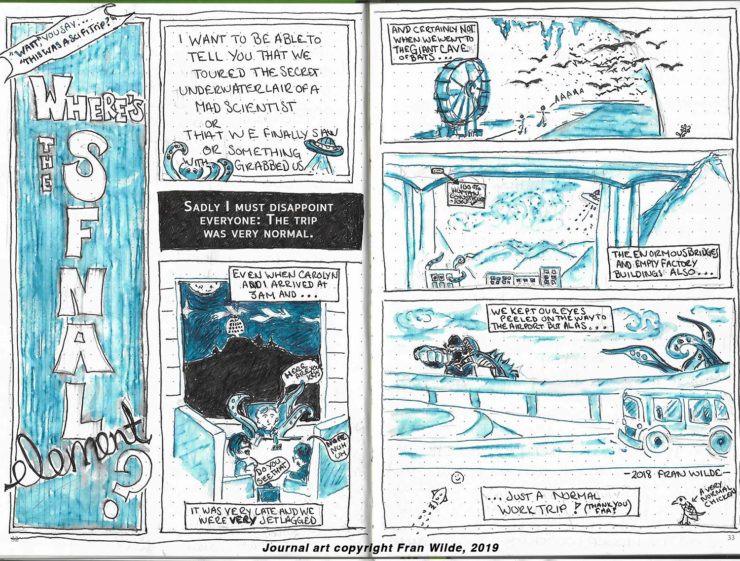
I am so very grateful to Vera Sun and Emily Gu, who organized the trip, and to all my fellow participants. It was a pleasure to travel with you.
As with all journals, all drawings, all stories, all experiences, some things are left out of the frame, missed, or excluded for various reasons, including personal ones. Just before we departed, a few more things happened that I didn’t draw. My passport was taken at the regional airport coming home, and returned only after an argument—I was told this was because I was traveling with a cane and needed assistance. (I got it back, but I’m flagging this for those considering traveling with a disability.) We arrived home to troubling reports that more crackdowns were taking place in China, especially in the northwest. All of this is part of the story, too—as much as all the places we visited, and I am working hard to increase my awareness.
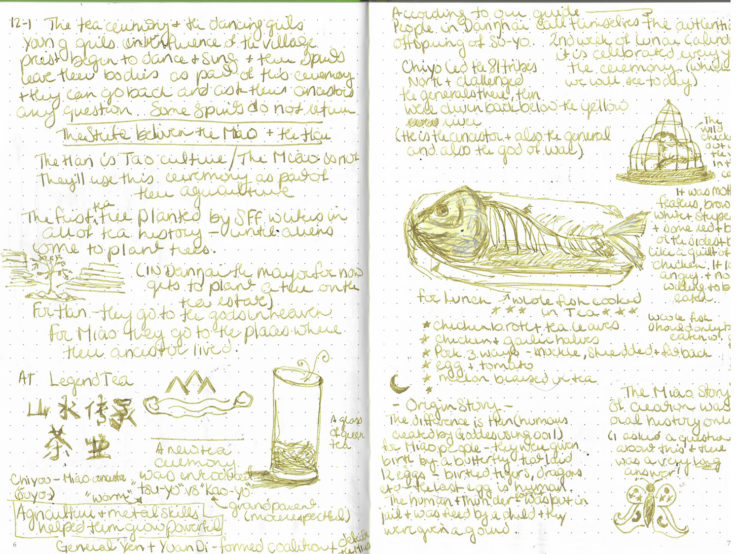
In the meantime, I am still working through my notes and journals, and I’ll be back to Tor.com soon to talk more about how different authors use journals.
Next time, I’ll be bringing some friends.
Fran Wilde’s novels and short stories have been finalists for three Nebula Awards, a World Fantasy Award, and two Hugo Awards, and include her Andre Norton- and Compton-Crook-winning debut novel Updraft, its sequels Cloudbound, and Horizon, her 2019 debut Middle Grade novel Riverland, and the Nebula-, Hugo-, and Locus-nominated novelette The Jewel and Her Lapidary. Her short stories appear in Asimov’s, Tor.com, Beneath Ceaseless Skies, Shimmer, Nature, and the 2017 Year’s Best Dark Fantasy and Horror. She writes for publications including The Washington Post, Tor.com, Clarkesworld, iO9.com, and GeekMom.com. You can find her on Twitter & Instagram (@fran_wilde), Facebook, and at franwilde.net.










